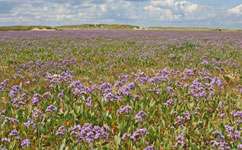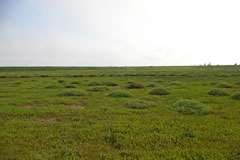Manmade marshes poorer in plant life than natural ones

Artificially created salt marshes are no substitute for natural ones, hosting fewer kinds of plant and often ending up overrun by just a few species, scientists have shown.
That's a problem, because the EU Habitats Directive obliges the UK to replace salt marsh that's lost to coastal development or erosion with new, 'biologically equivalent' habitat elsewhere. Until now we've thought we were complying, but the new study shows that making artificial salt marsh that's an adequate substitute for the real thing is a lot harder than we thought.
Natural salt marsh is a precious habitat that supports a very wide range of living things. It's home to plants, insects and birds that live nowhere else, and is greatly valued by naturalists and local people. The traditional assumption has been that if we let coastal land that was once salt marsh flood again – a process called managed coastal realignment (MCR) – then nature would do the rest, and in a few years we'd have serviceable salt marsh again.
A team of scientists from the University of East Anglia (UEA) examined 18 salt marshes created by deliberately allowing land to flood, as well as 17 that have been created accidentally when storm surges have overcome coastal defences. They compared the range and abundance of species growing there with those found in 34 natural salt marshes.
What they found was discouraging. Many of the plants common in natural salt marshes were rare or non-existent in artificial ones. These include species like sea lavender, thrift, sea arrowgrass and sea plantain. Instead, the man-made marshes had thin, scrappy vegetation and were often dominated by shrubs like sea purslane.
Even in marshes created by accidental flooding in the late 19th century, the mix of species still isn't close to that found on a natural salt marsh. So this isn't just a matter of needing to wait a few years for the natural balance to return. The scientists concentrated on plants, but it's likely they would have found a similar pattern if they'd looked at birds, invertebrates or other organisms.

'It's very difficult to go back to a natural state after land has been used for farming,' says Professor Alastair Grant of UEA, co-author of the study, which appears in the Journal of Applied Ecology. 'Flooding an agricultural soil doesn't produce a salt marsh soil, even if the land used to be salt marsh. This isn't esoteric stuff that's of interest only to naturalists; many of the species the public values most in salt marshes are almost completely absent in artificial ones. Existing approaches haven't succeeded in creating habitats that are biologically equivalent to natural salt marsh.'
Wetlands created through MCR have several problems compared to natural salt marsh, Grant explains. Often the land is too flat and low-lying, because long-term farming of land reclaimed from the sea has caused soil levels to fall steadily over the decades. This means the soil becomes waterlogged, preventing many saltmarsh species from establishing themselves and favouring just a few plants that quickly dominate the landscape. Even where soil levels are higher, stopping farming can often leave behind a hard, dry crust of soil that isn't suitable for most salt marsh plants but perfect for shrubs like sea purslane to take over and shade out competitors.
'Salt marsh formed naturally, so people have assumed that it would be straightforward to create it again – just let the sea back in,' Grant explains. 'Our study shows this isn't the case, and we're arguably not complying with the Habitats Directive.'
The picture isn't hopeless, though. Grant adds that since finishing the study, the team has continued to research the problem and how it might be solved, experimenting at sites including one on Wallasea Island in Essex, currently being turned into Europe's largest man-made nature reserve.
It turns out relatively simple measures can help bring new wetlands much closer to natural ones. These include raising valuable plants in nurseries and then planting them in artificial salt marshes, and taking care to vary their topography by making gullies, mounds and creeks that create conditions favourable for a variety of plants and prevent the dominance of any one species.
These measures aren't free, but nor are they expensive relative to the cost of the earthworks needed to create new salt marsh. And because they help create a richer and more diverse habitat, less area of new salt marsh may be needed to reproduce the ecological benefits of the lost wetlands, so the overall cost might even be lower.
More information: Hannah Mossman, Anthony Davy & Alastair Grant. Does managed coastal realignment create salt marshes with 'equivalent biological characteristics' to natural reference sites? Journal of Applied Ecology, 2012. doi: 10.1111/j.1365-2664.2012.02198.x
Journal information: Journal of Applied Ecology
Provided by PlanetEarth Online
This story is republished courtesy of Planet Earth online, a free, companion website to the award-winning magazine Planet Earth published and funded by the Natural Environment Research Council (NERC).

















